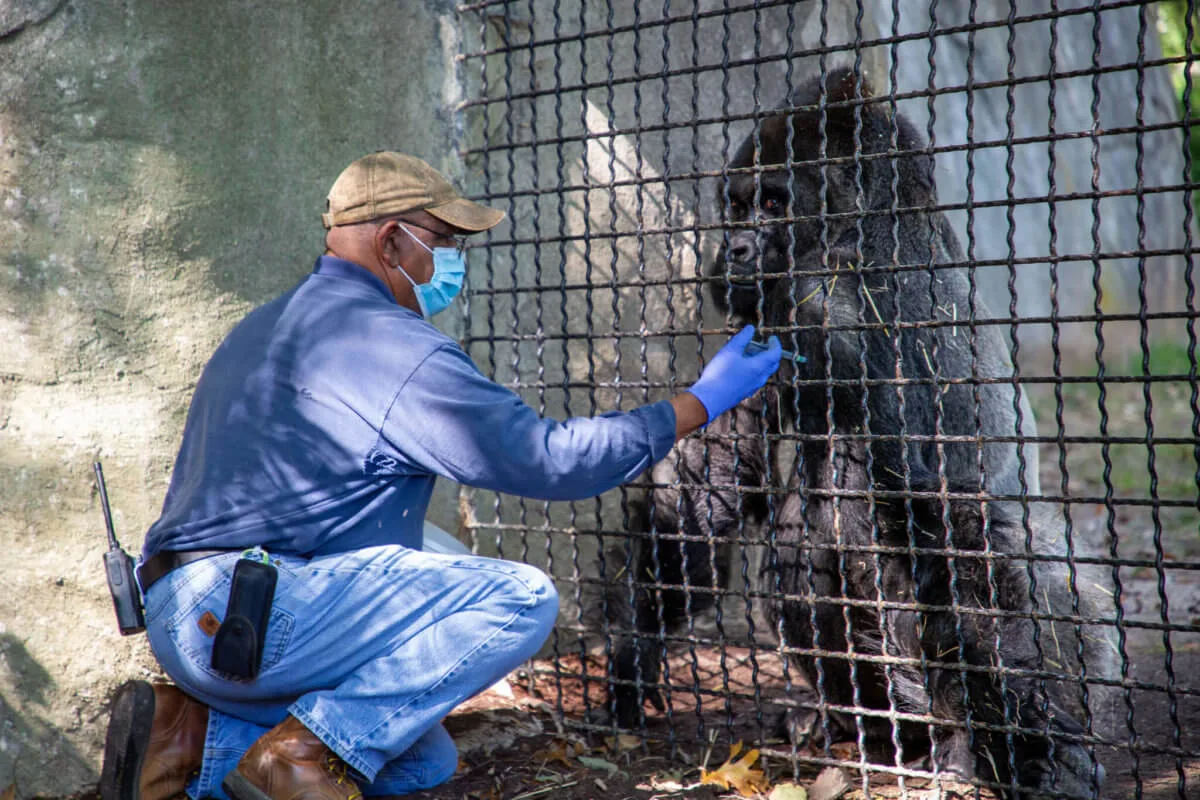
A silverback gorilla receives a COVID vaccine at the NC Zoo in October (Photo courtesy of the NC Zoo.)
Armed with protective gear and ground meat, NC Zoo workers delivered potentially life-saving shots this fall to primates and lions.
All seven of the gorillas at the North Carolina Zoo are vaccinated against COVID-19. So are all 15 of the chimps, both mountain lions and both African lions.
And each of them got the shot without complaint. Only the male sand cat refused.
Vaccine hesitancy? That’s a human thing.
“No one was darted, no one was physically restrained, they all came up and participated and we were able to administer the vaccine through behavioral training,” Dr. Jb Minter, the chief veterinarian of the NC Zoo, said in an interview with Cardinal & Pine.
We know North Carolina, inside and out. Subscribe to our free newsletter here.
The vaccine program is part of a national scientific trial that started soon after zoos across the country started seeing COVID cases among great apes, large cats, and a few other species.
COVID’s spread among zoo animals worldwide showed its own mysteries—gorillas seemed to get infected more easily than chimps, and big cats appear especially vulnerable to the disease.
Masking Up at the Zoo
The zoo has long required masks and other protective equipment for zoo staff who interact with the gorillas and chimps, because great apes, our closest genetic ancestors, can catch the cold and flu from us and give it right back. So when the pandemic started, staff immediately increased their safety measures, making the great ape mask protocol the policy for all mammals. All masks, all the time, no matter the animal, Minter said. (Minter has also been one of the stars in the new documentary series “Secrets of the Zoo: North Carolina now streaming on Disney+.)
The risk was serious.
“If a zookeeper or even one of the sanitation or maintenance workers get sick,” Minter said, “it could pose a direct threat to the animals.”

There have been nearly 130 COVID cases in animals throughout US zoos, according to the Animal and Plant Health Inspection Service, a division of the US Department of Agriculture, among them nearly 50 tigers, 40 lions, and 14 gorillas.
But with luck and protocols, there have been no COVID cases among the animals at the NC Zoo.
A vaccine became available through a trial from Zoetis, a company that is the animal kingdom’s version of Pfizer or Moderna, and the zoo was one of several across the country to sign up as an early participant.
The Zoetis vaccine is “uniquely formulated for animal species,” the company said in a news release in July, but works in much the same way as the human version. It’s given in two doses, three weeks apart.
In October, the North Carolina Zoo got 66 doses, enough to fully vaccinate 33 animals. They started with the apes, then moved to the mountain lions, lions, and sand cat.
The next batch has been ordered, but they are still waiting on state veterinarians from the NC Department of Agriculture to approve the order.
In the interim, they wait, mask, and decide what animals will be next. The zoo staff was eager to see their animals protected, Minter said.
“The animals are family to a lot of these keepers,” he said. “Some of these keepers have established very long relationships with some of the animals in their care.”
Vaccinating a Wild Animal
Vaccinating zoo animals has its own set of special logistical challenges.
To vaccinate your dog, a vet tech pets it and holds it steady while your local vet gives the shot. No one’s holding down a lion or a mountain gorilla.
“Our lions are wild; they’ll hurt you, potentially kill you if you were to go in there,” he said. “We would not encourage that at all.”
So they train them.
Using treats, the zoo trains their animals to do all sorts of things that make Minter’s job, and those of the zookeepers, easier. They can draw blood, or get the animals to show them their eyes or hurt paws, for example.
“There’s a lot that you can get these animals to do,” he said. “The lion will let you pull his tail, he’ll open his mouth if the zoo keeper asks, he’s trained to get on a scale.”
So getting the lion to present its shoulder for the shot was just a matter of offering the right “ground meat treat,” Minter said.
While food also worked well for the female sand cat, the male was not interested, Minter said.
“He wasn’t food motivated,” Minter said. “He did not want to participate and we weren’t going to force him to.”
Zoos are hesitant to anestesize animals, because a lot can go wrong in the process. So that timing all the more important.
“The biggest challenge for us was administering the vaccine without restraining the animals and ensuring that once a vial of 10 doses was opened you were able to administer all 10 in the short window. “
So far, the measures are working. Despite the case numbers in US zoos, the death rates have not been as bad as in humans. But some large cats have died of COVID, including four snow leopards, which are considered a threatened species in the wild.
It’s why they get vaccinated, Minter said. And it’s why humans should, too.
“Absolutely, humans getting vaccinated helps protect our animals,” Minter said.
So if the chance to save human lives is not enough for you to get your vaccine, what about the snow leopards? Does that do anything for you?
Politics

Emergency rooms refused to treat pregnant women, leaving one to miscarry in a lobby restroom
By AMANDA SEITZ Associated Press WASHINGTON (AP) — One woman miscarried in the lobby restroom of a Texas emergency room as front desk staff refused...

‘Unfit to be our next governor’: NC basketball greats speak out against Mark Robinson’s run for governor
NC has a long history of greatness on the basketball court. Now college basketball players from UNC, NC State, and Duke are wading into politics....
Local News

Good News Friday: It’s a good day to be a fan of the NC State Wolfpack
The men's and women's teams will compete for a national championship in college basketball this weekend. Plus: How to watch the solar eclipse, and...

The zodiac signs of 12 iconic women offer insight into their historic accomplishments
Zodiac signs can tell you a lot about someone’s personality. Whether they’re an earth, water, air, or fire sign, these 12 categories (which are...





